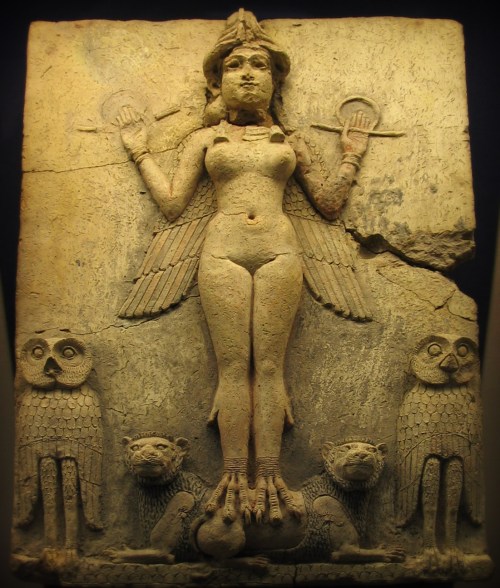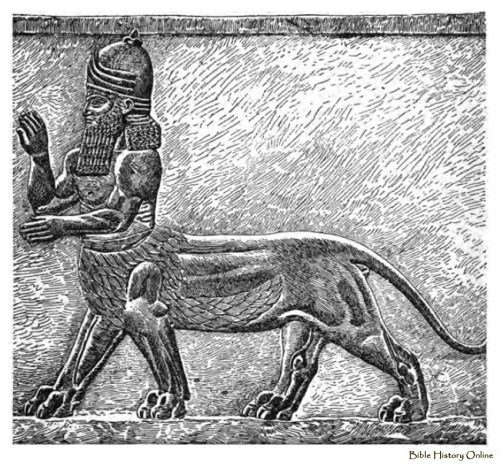Berossos and Chimeras
” … The point is rather that he exploited convergences between Greek and Mesopotamian thought so as to present himself as the kind of man whom Hellenistic Greek audiences would have recognized as σοφός, ‘wise’, or φιλόσοφος, ‘a lover of wisdom’.
In pursuit of this goal, Berossos seems to have proceeded eclectically, one might even say, opportunistically. His account of Tiamat’s army is telling in this regard. As expected, Berossos takes inspiration from the Enūma Eliš.
But he lists many creatures that are not found in the Babylonian epic, and some at least seem specifically added to appeal to a Greek audience. What is more, Berossos fundamentally changes the tone and overall meaning of the original, transforming the list of Tiamat’s monsters into a piece of philosophical speculation in the vein of Empedocles:
(It is said that) many creatures with two faces and two chests came into being, offspring of cows, with human prows, and others again growing forth with human physique and the head of oxen, mixed beings, partly equipped with female and partly with male members (Empedocles F61 DK).
Berossos’ account offers some remarkable similarities:
There was a time, he says, when everything was [darkness and] water and that in it fabulous beings with peculiar forms came to life. For men with two wings were born and some with four wings and two faces, having one body and two heads, male and female, and double genitalia, male and female.
Other men were born, some having the legs and the horns of goats, others with the feet of horses. Yet others had the hind parts of horses, but the foreparts of men, and were hippocentaurs in form.
Bulls were also engendered having the heads of men as well as four-bodied dogs having the tails of a fish from their hind parts, dog-headed horses and men and other beings having heads and bodies of horses, but tails of fish and still other beings having forms of all sorts of wild animals.
In addition to these, there were fish and reptiles and snakes and many other marvellous creatures differing in appearance from one another. Images of these were also set up in the temple of Belos.
The parallels between Empedocles and Berossos are glaring (bull-men, two-faced creatures, gender confusion, etc.), but can we seriously entertain the possibility that Berossos responded to Presocratic philosophy?

The Burney Relief, Babylon (1800-1750 BCE). A portrayal of Ishtar or Ereshkigal.
In line with the descriptions of Berossos, this goddess has wings and owl’s feet.
https://upload.wikimedia.org/wikipedia/commons/1/19/Burney_Relief_Babylon_-1800-1750.JPG
Allowing ourselves to contemplate this question can be a salutary exercise, but it need be no more than that: Berossos did not have to read Empedocles in order to learn about spontaneous generation. For that is what is at issue here: like Empedocles and others before him, Berossos presents his monsters as spontaneously sprung from primordial moisture: what was theogonic myth in Enūma Eliš becomes for him a question of physics.
And a hotly debated question at that: Empedocles always remained associated with the idea of primordial monsters, but already Aristotle built it into a much more far-reaching argument about purpose in nature.
[ … ]
Apollonius exploits the fact that early monsters were a source of ‘wonder’ (θάμβος), an idea which recalls Berossos’ emphasis on the miraculous nature of Tiamat’s creatures (τερατώδη, θαυμαστά). At a fairly basic level, this kind of thing was good box office.

I am unsure what to make of these eagle-headed entities. Some old sources claim that they portray Asshur.
Others call them “genies,” and note that they have wings, which is an indicator of divinity.
In this case the being tends to a tree of life, or tree of knowledge.
This bas relief is in the Louvre.
Primary publication Nimrud NW Palace I-24 = RIMA 2.0.101.023, ex. 189 (f)
Collection Nimrud, Iraq (a); British Museum, London, UK (b); Louvre Museum, Paris, France (c); Nimrud, Iraq (d); Detroit Institute of Arts, Detroit, Michigan, USA (e); British Museum, London, UK; Louvre Museum, Paris, France (f); unlocated (g)
Museum no. Nimrud fragment no. 42 (a); BM 098061 (b); AO 22198 (c); Nimrud fragment no. 43 and 45 (d); DIA 47.181 (e) (photo: DIA); AO 19849 (f); unlocated (g)
Accession no. 1903-10-10, 0002 (b)
Provenience Kalhu (mod. Nimrud)
Period Neo-Assyrian (ca. 911-612 BC)
Dates referenced Assurnasirpal2.00.00.00
Material stone: limestone
Language Akkadian
Overview at <http://cdli.ucla.edu/projects/nimrud/index.html>
Yet, we have seen that primordial monsters also had a more serious philosophical point. Apart from Aristotle, the Epicureans too grappled with the legacy of Empedocles’ idea, accepting spontaneous generation as an important part of their non-teleological account of the universe, but rejecting some of its more extravagant implications.”
Johannes Haubold, “The Wisdom of the Chaldaeans: Reading Berossos, Babyloniaca Book 1,” from Johannes Haubold, Giovanni B. Lanfranchi, Robert Rollinger, John Steele (eds.), The World of Berossos, Proceedings of the 4th International Colloquium on the Ancient Near East Between Classical and Ancient Oriental Traditions, Harrassowitz Verlag, Wiesbaden, 2013, pp. 37-9.

